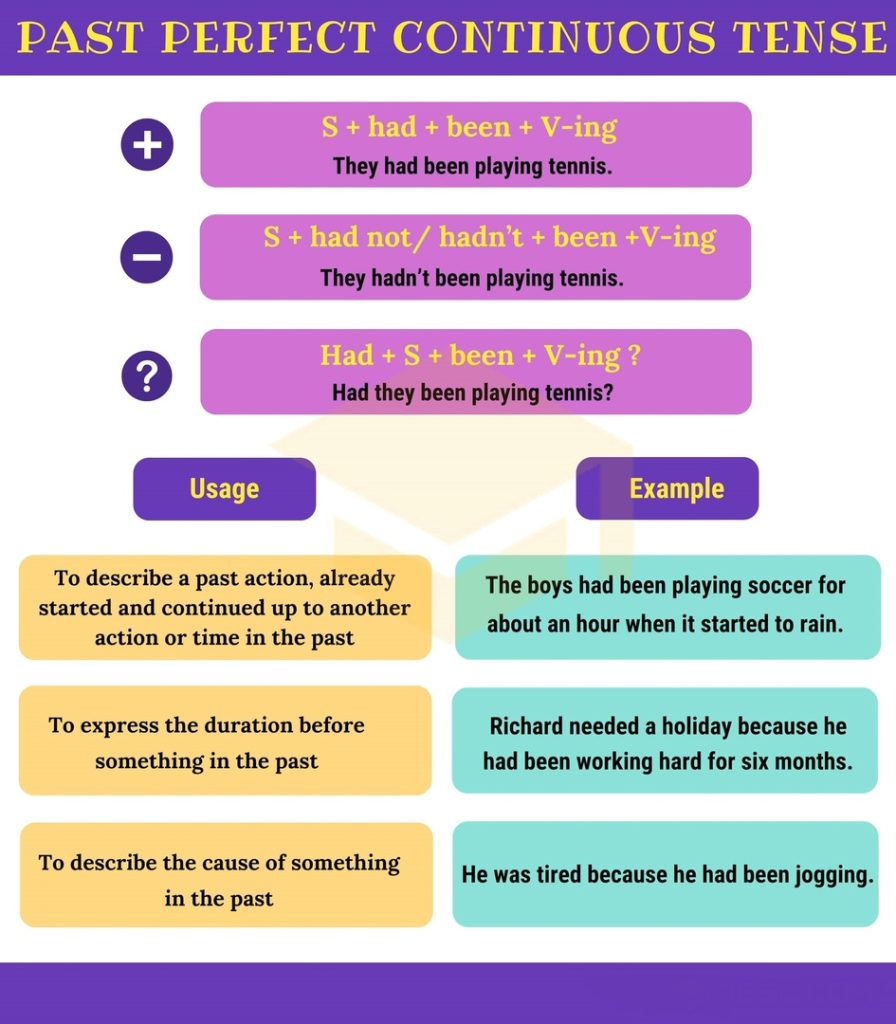The Past Perfect Continuous Tense and its Impact on IELTS
The English language is rich with various tenses that convey different aspects of time and actions. One of these essential tenses is the past perfect continuous tense. Understanding and effectively using this tense is crucial for achieving a high score on the IELTS test. In this article, we will explore the past perfect continuous tense, its forms, usage, and its role in the context of IELTS.

1. What is past perfect continuous tense?
The past perfect continuous tense is a grammatical form that indicates a continuous action or event that started in the past and continued up to another point in the past. It emphasizes the duration or ongoing nature of the action before a specific time or event in the past.
2. What is the past perfect continuous form?
The past perfect continuous tense is formed using the auxiliary verb “had been” followed by the base form of the main verb and the “ing” suffix (-ing form). Here is the general structure for forming the past perfect continuous tense:
- Subject + had been + V-ing
Examples of the past perfect continuous tense in different forms are as follows:
2.1. Affirmative
- I had been studying for hours.
- They had been working on the project all night.
2.2. Negative
- She had not been reading the book for long.
- We had not been waiting for too long.
2.3. Interrogative
- Had they been traveling for a week?
- Had you been practicing the piano all morning?
These examples demonstrate how to structure and use the past perfect continuous tense in affirmative, negative, and interrogative sentences.
3. How to use past perfect continuous tense?
The past perfect continuous tense is used to describe actions or events that were ongoing, continuous, or in progress at a specific point in the past and continued up to another specified point or event in the past. It emphasizes the duration and continuity of the action. Here are the primary situations in which the past perfect continuous tense is commonly used:
3.1. Action Over a Period Leading Up to Another Point in the Past
- She had been working at the company for five years before she was promoted.
- We had been waiting for the bus for over an hour when it finally arrived.
3.2. Cause of a Condition or Situation
- He looked exhausted because he had been running a marathon.
- The garden was flooded because it had been raining heavily all night.
3.3. Background Information in Past Narratives
- When I arrived, they were tired because they had been cleaning the house all day.
- The car broke down because it had been having engine problems for a while.
3.4. Expressing Regret or Annoyance
- I’m sorry I’m late. I had been getting caught in traffic.
- She was upset because her phone had been acting up for weeks.
In these instances, the past perfect continuous tense helps convey the ongoing nature of an action or event leading up to a particular point or situation in the past. It is essential for providing context and showing the relationship between different past events.

4. What are the differences between past perfect continuous and past continuous tense?
The past perfect continuous tense and the past continuous tense are both used to describe actions in the past, but they serve different purposes and convey different aspects of those actions. Here are the key differences between the two tenses:
| Aspect | Past continuous | Past perfect continuous |
| Duration and time | focuses on an ongoing action at a specific point in the past | emphasizes the duration of an ongoing action leading up to another point in the past |
| Formation | using “was/were” + the base form of the verb + “-ing” (e.g., was/were + verb-ing) | using “had been” + the base form of the verb + “-ing” (e.g., had been + verb-ing) |
| Usage and purpose | describes ongoing actions in the past at a specific moment or event | describes the ongoing nature of an action leading up to another event or point in the past |
| Example | She was cooking dinner when the phone rang | She had been cooking dinner for an hour when the phone rang |
5. What is the role of past perfect continuous tense in IELTS?
The past perfect continuous tense plays a crucial role in the IELTS, particularly in the writing and speaking sections. Demonstrating the ability to use this tense accurately and appropriately showcases a higher level of language proficiency and can positively impact your score. Here’s how the past perfect continuous tense is relevant in grammar for IELTS:
5.1. Complex Sentence Structures
Utilizing the past perfect continuous tense allows you to construct more complex and varied sentence structures. This showcases your ability to handle sophisticated grammatical forms, enhancing the complexity of your writing and speaking tasks.
5.2. Range of Tenses
IELTS assesses your ability to use a wide range of grammatical structures, including different tenses. Incorporating the past perfect continuous tense demonstrates your proficiency in using less common or advanced tenses, which can contribute to a higher score in the grammatical range criterion.
5.3. Narrating Past Actions and Events
In the IELTS speaking test, you might need to describe past experiences or events. Using the past perfect continuous tense allows you to vividly explain ongoing actions and their duration leading up to a specific moment in the past.
5.4. Expressing Cause and Effect
The past perfect continuous tense can be employed to show the cause or reason behind a situation or event in the past. This is essential for explaining past scenarios or conditions, which may be required in tasks like describing trends or processes.
5.5. Enhanced Cohesion and Coherence
Proper use of the past perfect continuous tense contributes to clear and coherent communication, which is fundamental in both writing and speaking tasks. It aids in presenting a logical sequence of events and ideas, thereby improving your coherence and cohesion scores.
5.6. Grammar and Accuracy
IELTS assesses your grammatical accuracy. Correctly using the past perfect continuous tense demonstrates your ability to use complex tenses with precision, positively impacting your score in the grammatical accuracy criterion.
Overall, integrating the past perfect continuous tense effectively in your responses during the IELTS exam reflects a higher level of English language proficiency, showcasing your capability to manipulate grammar accurately and enhancing the overall quality of your written and spoken English.

6. Example exercises of past continuous tense
Here are some example exercises to practice using the past continuous tense:
Exercise 1:
Rewrite the sentences in the past continuous tense.
- She eats breakfast every morning.
=> She was eating breakfast every morning.
- They play soccer after school.
=> They were playing soccer after school.
- I write a letter to my friend.
=> I was writing a letter to my friend.
Exercise 2:
Create a sentence using the past continuous tense. Choose the correct verb and form it accordingly.
- She / read
=> She was reading a book.
- They / talk
=> They were talking to each other.
- He / drive
=> He was driving to work.
Exercise 3:
Fill in the blanks with the correct form of the verbs in the past continuous tense.
- While I __________ (watch) TV, the power went out.
=> While I was watching TV, the power went out.
- They __________ (play) in the garden when it started raining.
=> They were playing in the garden when it started raining.
- She __________ (read) a book while waiting for the bus.
=> She was reading a book while waiting for the bus.
These exercises will help reinforce your understanding of how to use the past continuous tense in various contexts and sentences.
In conclusion, mastering the past perfect continuous tense and understanding its correct usage is pivotal for success in the IELTS exam. It demonstrates your language proficiency and contributes to a more advanced and varied use of English, ultimately improving your performance on the test. Thus, take our IELTS online test to sharpen your skills and achieve a high score on the IELTS test.